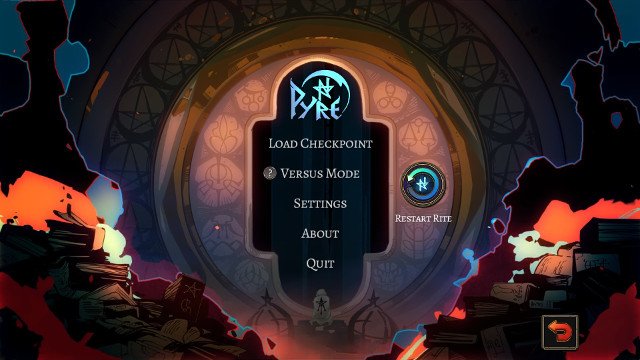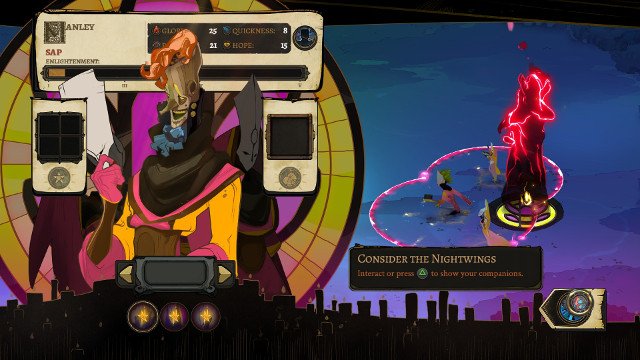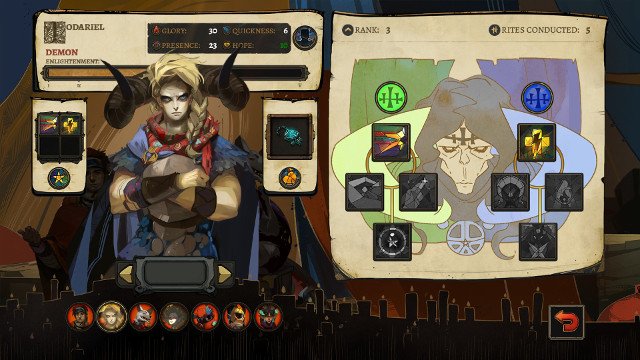If you haven’t heard of Pyre, then you must not be all that in-tune with the indie game scene. It’s the next game by the Supergiant Games, the development studio behind the indie mega-hits Bastion and Transistor.
If you have heard of Pyre, you’re likely eagerly anticipating its release tonight on PC and PS4. If that’s the case, though, make sure you know what you’re getting in to. Unlike many other indie studios, Supergiant Games doesn’t seem willing to just “stick to what they know,” so to speak, so you won’t be getting a re-skinned version of those two beloved titles. No matter what you’re expecting, though, don’t run into Pyre blindly. Here are 5 Pyre tips to help you out along your journey.
1. Use a Controller
This tip is certainly more beneficial to players on PC, but it can’t go without saying. There are three main control schemes you can choose as a baseline on the PC, one using the mouse to move, one using WASD to move and one using the mouse to move, but relying on QWER to do most everything else, similar to how a MOBA works.
That said, all of these control schemes pale in comparison to the controller. Even though you can re-map every key in Pyre, there still isn’t any way to top what the controller can bring to the table. We have a more in-depth guide on re-mapping controller buttons (which we’ve done in the image above), but the main takeaway is that you can map Sprint to L3, meaning you essentially only need one button to both move and sprint, whereas every other control scheme requires two button presses.
And don’t worry if you get lost while re-mapping. The tooltips that Pyre gives you will change based on whatever your current control scheme is.
2. You Can Restart Rites at Any Point

Pyre offers a rare mechanic as far as progression goes. Rather than have you try to beat an encounter, fail and have to try again until you get it right, Pyre will simply keep the game moving after you fail an encounter.
These encounters, called Rites, are the game’s premier gameplay offering and they’re wildly fun. But, they can also be a tough challenge, particularly if you play on a higher difficulty (which I strongly recommend for anyone at all experienced with video games).
If you feel you’re about to lose, but you don’t want to face the music and find out what happens if you fail at that Rite, then simply hit the pause button and use the fancy “Restart Rite” button. This will give you a no-strings-attached mulligan that can be repeated an infinite amount of times. So if you’re a perfectionist, go for it.
3. You Can See Your Opponents’ Stats

In Pyre, you control three characters (called Exiles) in any of its Rites – the primary form of gameplay. However, you’ll gain access to more than double that amount within just a few hours of the game, and choosing your roster can be both a strategic and an emotional challenge.
If you pick an Exile too slow, and the enemy team has small speedy guys, you’ll probably have a hard time. Likewise, you might run into trouble if your enemy team has a higher overall presence, because they’ll be able to outrange you, so to speak.
That said, this actually isn’t a blind gamble like I thought it was going into Pyre. Once a Rite starts, you can click a button toward the bottom right corner of the screen that allows you to see the stats of your opponents. You can tell how fast they are, how much damage they can do to your pyre, how large their Aura is and how long it will take them to respawn. You can use this knowledge to, in essence “counter-pick” against your opponents during the campaign, and it will make coming out the victor a lot easier.
4. Have Optional Conversations

In your down time, you’ll be presented the opportunity to peruse the wagon, the form of transportation for your band of Exiles. In this Wagon, you’ll see things that let you change the music, outfit your Exiles with different items, do practice matches and much more.
Every now and again, though, you’ll be presented the opportunity to talk with one of the Exiles in your group. As someone who has been around the block with games like this, I thought I sized them up appropriately as fruitless story filler that I could skip if I found myself short on patience.
Boy was I wrong. Turns out that these option conversations will often (though not always) grant the Exile you talked with a temporary bonus for the next Rite. While this is usually just a modest stat increase, it’s money on the table otherwise, and you can always just hurry through the dialogue if it really can’t hold your attention.
5. Exiles Can Only Learn Four Masteries

We’ve all seen skill trees before. You earn experience from doing the video game stuff, that experience feeds into a level bar, and you can unlock new abilities (called Masteries in Pyre) each time you level up. For a game so otherwise unconventional, Pyre seemed to be taking the road most-traveled in this particular case.
But, look more closely and you’ll reveal a terrifying truth. Exiles start at level one with no abilities unlocked, and their maximum bar is level five. That means that you will only even be able to unlock four Masteries out of a possible eight. Worse yet, these eight Masteries are split into two trees. This means that if you unlock the second tier Mastery in one tree, you will never be able to unlock the third-tier Mastery in the other tree.
So, before looking at each tier-one Mastery, find out what the tier-three Mastery is and decide which one you want more. After that, unlock Masteries in the tree that corresponds to your most-desired tier-three Mastery. This does allow you to unlock the first-tier Mastery in each tree and still have flexibility, but once you unlock the second-tier Mastery in either Tree, you’re committed to that Tree.







